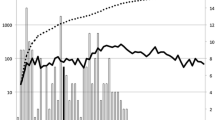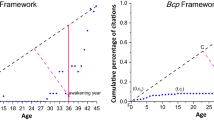Abstract
Judah Folkman is considered the father of angiogenesis research. However, his hypothesis on tumor angiogenesis initially met with considerable skepticism. Scientific resistance has been described in the sociology of science, and leads to delayed recognition of pioneering work. In bibliometrics, delayed recognition is characterized by papers referred to as “sleeping beauties”. Sleeping beauties do not achieve recognition in terms of citations until they are awakened a few years after their original publication. The study of sleeping beauties is necessary to understand scientific knowledge better. The present paper explores the extent to which the phenomenon of delayed recognition affected Folkman’s body of work by analyzing his scientific production and the citation life of his publications. Citation analysis shows that Folkman’s landmark paper published in 1971 is a sleeping beauty. Scientometric analysis was combined with a qualitative analysis of the Folkman case in order to shed light on the reasons behind this delayed recognition, and the awakening of the “Sleeping Beauty” by a “Prince”, thus attracting a lot of attention in terms of citations. Interestingly, the fact that Judah Folkman was one of the co-authors of the Prince paper challenges the practice of excluding self-citations when conducting bibliometric analysis. By continuously citing his own paper after years of sleep, Folkman demonstrated his persistence and belief in the importance of his theory. Constancy and continuity in research are important components in ensuring the acceptance of unpopular hypotheses and the development of new research fields.




Similar content being viewed by others
References
Barber, B. (1961). Resistance by scientists to scientific discovery. Science, 134(3479), 596–602. https://doi.org/10.1126/science.134.3479.596.
Bikfalvi, A. (2016). Une brève histoire du vaisseau sanguin et lymphatique. Montrouge: EDP Sciences.
Bischoff, J., & Griffioen, A. W. (2008). In memoriam Dr. Judah Folkman. Angiogenesis, 11(1), 1–2. https://doi.org/10.1007/s10456-008-9103-7.
Brouty-Boye, D., & Zetter, B. (1980). Inhibition of cell motility by interferon. Science, 208(4443), 516. https://doi.org/10.1126/science.6154315.
Cao, Y., & Langer, R. (2008). A review of Judah Folkman’s remarkable achievements in biomedicine. Proceedings of the National Academy of Sciences. https://doi.org/10.1073/pnas.0806582105.
Costas, R., van Leeuwen, T. N., & van Raan, A. F. J. (2010). Is scientific literature subject to a “Sell-By-Date”? A general methodology to analyze the “durability”of scientific documents. Journal of the American Society for Information Science and Technology, 61(2), 329–339. https://doi.org/10.1002/asi.21244.
Costas, R., van Leeuwen, T. N., & van Raan, A. F. J. (2011). The “Mendel syndrome” in science: Durability of scientific literature and its effects on bibliometric analysis of individual scientists. Scientometrics, 89(1), 177–205. https://doi.org/10.1007/s11192-011-0436-4.
Cressey, D. (2015). “Sleeping beauty” papers slumber for decades. Nature News. https://doi.org/10.1038/nature.2015.17615.
de Solla Price, D., & Gürsey, S. (1976). Studies in scientometrics. I. Transience and continuance in scientific authorship. International Forum on Information and Documentation, 1(2), 17–24.
Du, J., & Wu, Y. (2016). A bibliometric framework for identifying “princes” who wake up the “sleeping beauty” in challenge-type scientific discoveries. Journal of Data and Information Science, 1(1), 50–68. https://doi.org/10.20309/20160.
Ferrara, N., & Henzel, W. J. (1989). Pituitary follicular cells secrete a novel heparin-binding growth factor specific for vascular endothelial cells. Biochemical and Biophysical Research Communications, 161(2), 851–858. https://doi.org/10.1016/0006-291X(89)92678-8.
Folkman, J. (1971). Tumor angiogenesis: Therapeutic implications. New England Journal of Medicine, 285(21), 1182–1186. https://doi.org/10.1056/NEJM197111182852108.
Folkman, J. (1995). Clinical applications of research on angiogenesis. New England Journal of Medicine, 333(26), 1757–1763. https://doi.org/10.1056/NEJM199512283332608.
Folkman, J. (1996). Endogenous inhibitors of angiogenesis. Harvey Lectures, 92, 65.
Folkman, J. (2004). Endogenous angiogenesis inhibitors. APMIS: Acta Pathologica, Microbiologica, et Immunologica Scandinavica, 112(7–8), 496–507. https://doi.org/10.1111/j.1600-0463.2004.apm11207-0809.x.
Folkman, J. (2008a). History of angiogenesis. In W. D. Figg & J. Folkman (Eds.), Angiogenesis: An integrative approach from science to medicine (pp. 1–14). Boston, MA: Springer.
Folkman, J. (2008b). Tumor angiogenesis: From bench to bedside. In D. Marmé & N. Fusenig (Eds.), Tumor angiogenesis: Basic mechanisms and cancer therapy (pp. 3–28). Berlin: Springer.
Folkman, J., Long, D. M., & Becker, F. F. (1963). Growth and metastasis of tumor in organ culture. Cancer, 16(4), 453–467. https://doi.org/10.1002/1097-0142(196304)16:4<453:AID-CNCR2820160407>3.0.CO;2-Y.
Garfield, E. (1989a). Delayed recognition in scientific discovery-citation frequency-analysis aids the search for case-histories. Current Contents, 23, 3–9.
Garfield, E. (1989b). More delayed recognition. 1. Examples from the genetics of color-blindness, the entropy of short-term-memory, phosphoinositides, and polymer rheology. Current Contents, 38, 3–8.
Garfield, E. (1990). More delayed recognition. 2. From inhibin to scanning electron microscopy. Current Contents, 9, 3–9.
Glänzel, W. (2008). Seven myths in bibliometrics about facts and fiction in quantitative science studies. Collnet Journal of Scientometrics and Information Management, 2(1), 9–17. https://doi.org/10.1080/09737766.2008.10700836.
Glänzel, W., Schlemmer, B., & Thijs, B. (2003). Better late than never? On the chance to become highly cited only beyond the standard bibliometric time horizon. Scientometrics, 58(3), 571–586. https://doi.org/10.1023/B:SCIE.0000006881.30700.ea.
Gorry, P., & El Aichouchi, A. (2017). Sleeping beauty awakened by self-citation of a review: A case study of Judah Folkman’s hypothesis on angiogenesis. In ISSI 2017—16th international conference on scientometrics and informetrics, conference proceedings (pp. 778–786). Wuhan.
Gorry, P., & Ragouet, P. (2016). “Sleeping beauty” and her restless sleep: Charles Dotter and the birth of interventional radiology. Scientometrics, 107(2), 773–784. https://doi.org/10.1007/s11192-016-1859-8.
Hartley, J., & Ho, Y.-S. (2017). Who woke the sleeping beauties in psychology? Scientometrics, 112(2), 1065–1068. https://doi.org/10.1007/s11192-017-2326-x.
Hess, D. J. (2006). Antiangiogenesis research and the dynamics of scientific fields. In S. Frickel & M. Kelly (Eds.), The new political sociology of science: Institutions, networks and power (pp. 122–147). Wisconsin: University of Wisconsin Press.
Ho, Y.-S., & Hartley, J. (2017). Sleeping beauties in psychology. Scientometrics, 110(1), 301–305. https://doi.org/10.1007/s11192-016-2174-0.
Holmgren, L., O’Reilly, M. S., & Folkman, J. (1995). Dormancy of micrometastases: Balanced proliferation and apoptosis in the presence of angiogenesis suppression. Nature Medicine, 1, 149. https://doi.org/10.1038/nm0295-149.
Ke, Q., Ferrara, E., Radicchi, F., & Flammini, A. (2015). Defining and identifying Sleeping Beauties in science. Proceedings of the National Academy of Sciences, 112(24), 7426–7431. https://doi.org/10.1073/pnas.1424329112.
Kerbel, R. S. (2000). Tumor angiogenesis: Past, present and the near future. Carcinogenesis, 21(3), 505–515. https://doi.org/10.1093/carcin/21.3.505.
Klagsbrun, M., & Moses, M. A. (2008). Obituary: M. Judah Folkman (1933–2008). Nature, 451(7180), 781. https://doi.org/10.1038/451781a.
Kuhn, T. (1970). The structure of scientific revolutions. Chicago: University of Chicago Press.
LaBonte, M. L. (2014). Anticoagulant factor V: Factors affecting the integration of novel scientific discoveries into the broader framework. Studies in History and Philosophy of Science Part C: Studies in History and Philosophy of Biological and Biomedical Sciences, 47, Part A, 23–34. https://doi.org/10.1016/j.shpsc.2014.03.007.
Li, J. (2014). Citation curves of “all-elements-sleeping-beauties”:“Flash in the pan” first and then “delayed recognition”. Scientometrics, 100(2), 595–601. https://doi.org/10.1007/s11192-013-1217-z.
Li, J., & Fred, Y. Y. (2016). Distinguishing sleeping beauties in science. Scientometrics, 108(2), 821–828. https://doi.org/10.1007/s11192-016-1977-3.
Merton, R. K. (1988). The Matthew effect in science, II: Cumulative advantage and the symbolism of intellectual property. Isis, 79(4), 606–623. https://doi.org/10.1086/354848.
O’Reilly, M. S., Holmgren, L., Shing, Y., Chen, C., Rosenthal, R. A., Moses, M., et al. (1994). Angiostatin: A novel angiogenesis inhibitor that mediates the suppression of metastases by a lewis lung carcinoma. Cell, 79(2), 315–328. https://doi.org/10.1016/0092-8674(94)90200-3.
Ohba, N., & Nakao, K. (2012). Sleeping beauties in ophthalmology. Scientometrics, 93(2), 253–264. https://doi.org/10.1007/s11192-012-0667-z.
Popper, K. R. (1959). The logic of scientific discovery. New York: Basic Book.
Rastinejad, F., Polverini, P. J., & Bouck, N. P. (1989). Regulation of the activity of a new inhibitor of angiogenesis by a cancer suppressor gene. Cell, 56(3), 345–355. https://doi.org/10.1016/0092-8674(89)90238-9.
Ribatti, D. (2008). Judah Folkman, a pioneer in the study of angiogenesis. Angiogenesis, 11(1), 3–10. https://doi.org/10.1007/s10456-008-9092-6.
Shing, Y., Folkman, J., Sullivan, R., Butterfield, C., Murray, J., & Klagsbrun, M. (1984). Heparin affinity: Purification of a tumor-derived capillary endothelial cell growth factor. Science, 223(4642), 1296–1299. https://doi.org/10.1126/science.6199844.
Soff, G. A. (2000). Angiostatin and angiostatin-related proteins. Cancer and Metastasis Reviews, 19(1), 97–107. https://doi.org/10.1023/A:1026525121027.
Stent, G. S. (1972). Prematurity and uniqueness in scientific discovery. Scientific American, 227, 84–93. https://doi.org/10.1038/scientificamerican1272-84.
Teixeira, A. A. C., Vieira, P. C., & Abreu, A. P. (2017). Sleeping beauties and their princes in innovation studies. Scientometrics, 110(2), 541–580. https://doi.org/10.1007/s11192-016-2186-9.
Thor, A., Marx, W., Leydesdorff, L., & Bornmann, L. (2016). Introducing CitedReferencesExplorer (CRExplorer): A program for Reference Publication Year Spectroscopy with cited references standardization. Journal of Informetrics, 10(2), 503–515. https://doi.org/10.1016/j.joi.2016.02.005.
Van Calster, B. (2012). It takes time: A remarkable example of delayed recognition. Journal of the American Society for Information Science and Technology, 63(11), 2341–2344. https://doi.org/10.1023/B:SCIE.0000006881.30700.ea.
van Eck, N. J., & Waltman, L. (2010). Software survey: VOSviewer, a computer program for bibliometric mapping. Scientometrics, 84(2), 523–538. https://doi.org/10.1007/s11192-009-0146-3.
Van Raan, A. F. J. (2004). Sleeping beauties in science. Scientometrics, 59(3), 467–472. https://doi.org/10.1023/B:SCIE.0000018543.82441.f1.
Završnik, J., Kokol, P., del Torso, S., & Blažun Vošner, H. (2016). Citation context and impact of “sleeping beauties” in paediatric research. Journal of International Medical Research, 44(6), 1212–1221. https://doi.org/10.1177/0300060516672129.
Acknowledgements
The present study is an extended version of an article presented at the 16th International Conference on Scientometrics and Informetrics, Wuhan (China), 16–20 October 2017. This work was supported by an internship to Adil El Aichouchi granted by the Bordeaux’ University consortium on vascular aging (ATT-VIVA). We would like to thank Pascal Duris for his continual support and Andreas Bikfalvi for his insightful comments on the history and biology of angiogenesis.
Author information
Authors and Affiliations
Corresponding author
Rights and permissions
About this article
Cite this article
El Aichouchi, A., Gorry, P. Delayed recognition of Judah Folkman’s hypothesis on tumor angiogenesis: when a Prince awakens a Sleeping Beauty by self-citation. Scientometrics 116, 385–399 (2018). https://doi.org/10.1007/s11192-018-2752-4
Received:
Published:
Issue Date:
DOI: https://doi.org/10.1007/s11192-018-2752-4




